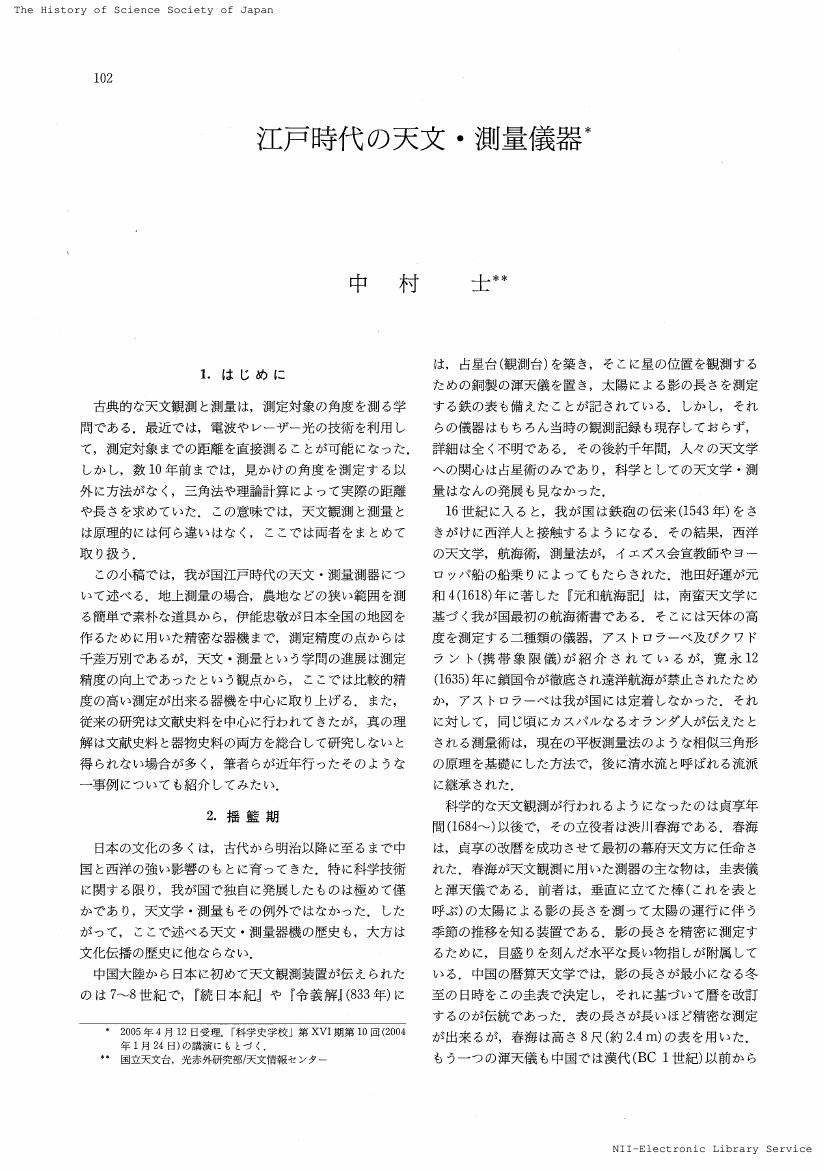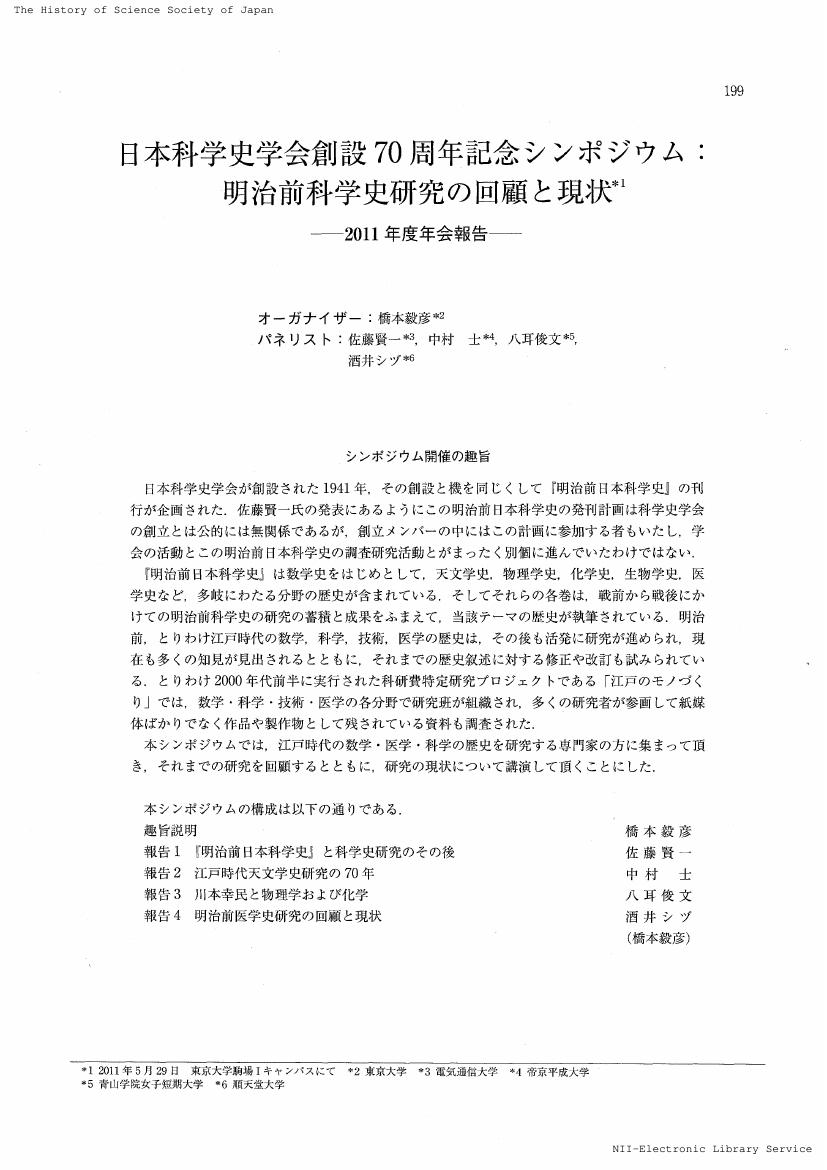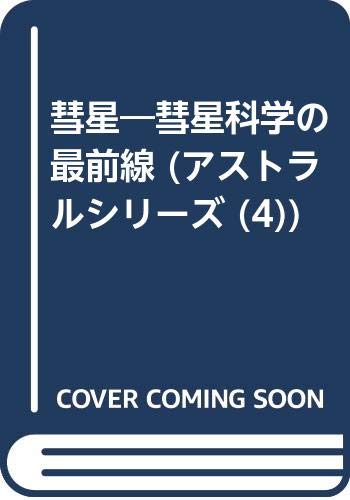3 0 0 0 天文と宇宙 : ギネスワールド
3 0 0 0 平成3年7月11日メキシコ日食による太陽コロナの観測
- 著者
- 山下 泰正 田邊 俊彦 磯部 しゅう三 西野 洋平 北井 礼三郎 末松 芳法 黒河 宏企 平山 淳 中村 士 代情 靖 船越 康宏
- 出版者
- 国立天文台
- 雑誌
- 国際学術研究
- 巻号頁・発行日
- 1990
1.研究の概要平成3年7月11日の皆既日食は、7分近い皆既継続時間を持つ今世紀最大規模のものであった。この貴重な機会を利用して、平常では十分行なうことが出来ない太陽コロナの精密観測を実施して、その物理状態を調べる事が本研究の目的であった。研究調査は、2年に跨ってメキシコ国内各所で行なわれ、初年度は観測地の調査選定を、本年度は皆既日食本観測を実施した。当初、メキシコ国内の治安の悪さ、自然環境の厳しさ等危惧されたが、初年度の予備調査により、晴天率、望遠鏡設置条件、居住条件、安全性、機材輸送経路等の諸条件を十分検討して観測地点を選択したこと、予めメキシコ大学その他現地の協力機関と折衝出来たこと等により、約40日にわたる本年度調査は、概ね順調に実施され、晴天にも恵まれて太陽コロナその他の観測に成功した。2.研究の実施経過日本観測隊は11名により構成された。内訳は国立天文台6名、京都大学理学部3名、海外保安庁水路部2名である。前者2機関9名が本研究計画により派遣されたものである。3チ-ム8名(国立天文台3名、京都大学3名、水路部2名)は、カリフォルニア半島南端のラパス市にて、1チ-ム(国立天文台3名)が、メキシコ市南東のポポカテペトル山(5452m)にて観測した。全員メキシコ市日本大使館にて打ち合わせた後、2箇所に分かれて、設営準備を開始した。ラパス隊はカリフォルニア半島北端のエンセナ-ダ港にて、観測機材(全重量8.7トン)の通関手続きを行った後、トラック2台によりラパス市までの1600kmを陸送した。予め選定していたラパス市郊外の南バハカリフォルニア自治大学の運動場にて、観測機械を設置し、調整、テスト観測等約20日間余りにわたる準備を行なった末、皆既日食当日に臨んだ。当日は快晴に恵まれ、観測機器も順調に作動して観測に成功した。観測機材散収梱包作業後、再びトラックにて陸送し、エンセナ-ダ港にて通関手続き、船積み手続き完了後メキシコ市に帰還した。ポポカテペトル隊は、メキシコ大学天文学教室の応援を得て、5400mの山頂付近に観測機器を設置した。皆既当日は朝から快晴で、後半薄雲の影響を受けたものの、観測機器も正常に作動して観測に成功した。3.研究の成果得られた多くの観測デ-タの解析は現在進行中であるが、観測デ-タの内容と予備的な解析結果はすでに、別冊の研究成果報告書「平成3年7月11日メキシコ日食による太陽コロナの観測」としてまとめられている。その概要は次の通りである。(1)太陽コロナの微細構造の観測によるコロナの熱力学構造の研究。異なる温度構造を代表する4本の輝線、既ち中性水素輝線Hα(1万度)、9回電離鉄イオン6374輝線(100万度)13回電離鉄イオン5303輝線(200万度)、14回電離カルシウム5694輝線(350万度)と連続光の、合計5種類の単色フィルタ-によって、内部コロナの単色像を多数撮影した。これによってコロナ中の高温ル-プ、低温ル-プ、紅炎周縁等の微細温度構造を示すデ-タを、従来にない高分解能で得ることに成功した。予備的な解析から、コロナのル-プ構造は従来から考えられていた「中心が冷たく外側が高温」の同軸モデルでは説明できない構造が多いことが判った。(2)太陽コロナ中の低温物質の起源の研究中性ヘリウむ輝線10830(1〜10万度)と10000オングストロ-ム連続光及び13回電離鉄輝線5303の単色像を撮影すると同時に、紫外領域と赤外領域の偏光分光観測により、カルシウムイオンH.K輝線、ヘリウム10830輝線等のスペクトルを多数撮影した。予備的な解析によると、コロナ中には、紅炎以外には、はっきり検出できる低温物質が存在しないようである。又、Kコロナの観測から、コロナストリ-マ-の太さを調べた結果、太陽表面では約15〜40秒角の大きさの構造につながる事が判った。(3)太陽周縁の塵の研究4波長(5325A、5965A、7200A、8015A)の広帯域フィルタ-と偏光板によって、外部コロナの二次元偏光測光を行い、偏光の二次元分布図を作成した。これから、真のFコロナ偏光成分を求めるためには、地球大気によるバックグラウンド偏光成分とKコロナのストリ-マ-偏光成分とを分離する必要があり現在整約を続行中である。これにより、太陽周縁の惑星間塵の分布及び物理状態を調べることが出来る。
2 0 0 0 OA 江戸時代の天文・測量儀器(科学史入門)
- 著者
- 中村 士
- 出版者
- 日本科学史学会
- 雑誌
- 科学史研究 (ISSN:21887535)
- 巻号頁・発行日
- vol.44, no.234, pp.102-105, 2005 (Released:2021-08-12)
2 0 0 0 OA 科学史入門 江戸時代前期の日本望遠鏡
- 著者
- 中村 士
- 出版者
- 日本科学史学会
- 雑誌
- 科学史研究 (ISSN:21887535)
- 巻号頁・発行日
- vol.54, no.274, pp.53, 2015 (Released:2020-12-14)
2 0 0 0 OA すばる望遠鏡による微小小惑星のライトカーブサーベイ
- 著者
- 吉田 二美 デルマワン ブディ 中村 士 柳沢 俊史 黒崎 裕久 中島 厚 伊藤 孝士
- 出版者
- 日本惑星科学会
- 雑誌
- 日本惑星科学会秋季講演会予稿集 日本惑星科学会2005年秋季講演会予稿集
- 巻号頁・発行日
- pp.45, 2005 (Released:2006-07-24)
8.2mのすばる望遠鏡と0.25平方度の広視野を持つ主焦点カメラSuprime-Camを組み合わせて、見かけの等級が約20-24等という微小メインベルト小惑星を100個同時に検出し、それらのライトカーブを得た。それらの自転周期分布を調べた結果、「全体の約25%が自転周期2時間以下のいわゆる高速自転小惑星である」という驚くべき結果を得た。高速自転小惑星はこれまで近地球小惑星のグループだけに発見されていたが、我々の結果はこれまで調べられていなかったメインベルトの微小サイズの小惑星には大きい割合で高速自転小惑星が存在することを示唆している。
2 0 0 0 キトラ古墳星図および関連史料の成立年の数理的再検討
- 著者
- 中村 士
- 出版者
- 日本科学史学会
- 雑誌
- 科学史研究. [第III期] (ISSN:21887535)
- 巻号頁・発行日
- vol.54, no.275, pp.192-214, 2015-10-24
A star map with an elaborate appearance was discovered in 1998 on the ceiling inside the Kitora burial mound of Nara Prefecture (hereafter we call it the Kitora star map). From archaeological evidence, this ancient tumulus is considered to have been constructed between the end of the 7th century and the beginning of the 8th century. We had a chance to make anew positional measurements of the 28-xiu constellations depicted on this circular star map, with the purpose of inferring their observed time epoch. As sky positions of stars are subject to change due to the precession, we can estimate when the stars in the Kitora star map were observed. We adopted a statistical least-squares approach to minimize the mean positional shift for all the 28-xiu standard stars, where the positional shift of a star means the difference between its measured position and the one calculated using precession theory. For a confidence level of 90%, the confidence interval of the observation year for the Kitora star map was found to be [123BC, 39BC], or approximately 80BC ± 40. This obviously indicates that the star map is of Chinese origin. Thus, in order to investigate the relationship of the Kitora star map to ancient Chinese star catalogs, we made a statistical analysis of Shi-shi's Star Catalog, the oldest star catalog in China. By applying to it the same analysis technique as the one adopted for the Kitora star map, we obtained the confidence interval to be [65BC,43BC]. Comparison of this interval with that for the Kitora star map strongly suggests that the latter was drawn based on the Shi-shi's Catalog. A similar analysis of the Korean star map stone-inscribed in the 14th century, Ch'onsang Yolch'a Punyajido, also showed nearly the same time epoch. Finally we discuss the political and social background why the Kitora star map was produced in such an early time in Japan.
1 0 0 0 OA 日本科学史学会創設70周年記念シンポジウム,2011年度年会報告
1 0 0 0 OA 幕府天文方高橋至時 : その生涯,業績と影響(科学史入門)
- 著者
- 中村 士
- 出版者
- 日本科学史学会
- 雑誌
- 科学史研究 (ISSN:21887535)
- 巻号頁・発行日
- vol.48, no.251, pp.156-161, 2009 (Released:2021-08-03)
1 0 0 0 OA 日本最古の徳川義直公望遠鏡
- 著者
- 中村 士
- 出版者
- 日本科学史学会
- 雑誌
- 科学史研究 (ISSN:21887535)
- 巻号頁・発行日
- vol.48, no.250, pp.98-108, 2009 (Released:2021-08-04)
Although historical records show that a telescope was first brought about into Japan as early as in 1613, existing telescopes in Japan produced before 1750 are rare and have never been examined in detail. In 2003 and 2005, we had a chance to scrutinize the antique telescope owned by one of feudal warlords, Tokugawa Yoshinao, who was the ninth son of the first Shogun Iyeyasu and inherited a large han (clan) at Owari-Nagoya district. Since Yoshinao died in 1650, it means that his telescope was made in or before that year. Our investigations of the telescope revealed that it is of Schyrlean type, namely, a more advanced one than the Galilean telescope, consisting of four convex lenses. In Europe, the invention of the Schyrlean telescope was publicized in 1645. Optical measurements showed that Yoshinao's telescope gave erect images with a measured magnifying power of 3.9 (+/- 0.2-0.3). The design, fabrication technique of the tube and caps of the telescope, and tube decoration all point to that it is neither a Western product at all nor a pure Japanese make. It is likely that the telescope was produced probably under the guidance of the Jesuit missionary in China or by the native Chinese, near cities of Suzhou or Hangzhou in Zhejiang province of the continental China, or at Nagasaki. Based on the Japanese and Chinese historical literature, we also discuss the possibility that production of the Schyrlean telescope could have begun independently in the Far East, nearly simultaneously with the invention of that type in Europe.
1 0 0 0 OA シンポジウム:加賀と近江 : 地域と人脈から見る近世科学史(2002年度年会報告)
1 0 0 0 彗星 : 彗星科学の最前線
1 0 0 0 小特集 渋川春海没後300周年 : 渋川春海研究の新展開に向けて
- 著者
- 中村 士 吉田 忠
- 出版者
- 日本科学史学会
- 雑誌
- 科学史研究 (ISSN:21887535)
- 巻号頁・発行日
- vol.54, no.276, 2016
- 著者
- 中村 士
- 出版者
- 日本科学史学会
- 雑誌
- 科学史研究 (ISSN:21887535)
- 巻号頁・発行日
- vol.59, no.294, pp.172-179, 2020 (Released:2021-01-24)
1 0 0 0 OA 小特集 日本における黎明期の科学史研究と戦後の復興
- 著者
- 溝口元 中村士 山田俊弘 岡田大士 河村豊 渋谷一夫
- 出版者
- 日本科学史学会
- 雑誌
- 科学史研究 (ISSN:21887535)
- 巻号頁・発行日
- vol.58, no.291, pp.249-299, 2019 (Released:2021-01-24)
1 0 0 0 惑星のリングはなぜあるのか : 木星・土星・天王星
- 著者
- J.エリオット R.カー [著] 中村士 相馬充訳
- 出版者
- 岩波書店
- 巻号頁・発行日
- 1987
- 著者
- 中村 士
- 出版者
- 日本科学史学会
- 雑誌
- 科学史研究. 第II期 (ISSN:00227692)
- 巻号頁・発行日
- vol.50, no.260, pp.202-206, 2011-12-27
1 0 0 0 日本最古の徳川義直公望遠鏡
- 著者
- 中村 士
- 出版者
- 日本科学史学会
- 雑誌
- 科学史研究. 第II期 (ISSN:00227692)
- 巻号頁・発行日
- vol.48, no.250, pp.98-108, 2009-06-25
Although historical records show that a telescope was first brought about into Japan as early as in 1613, existing telescopes in Japan produced before 1750 are rare and have never been examined in detail. In 2003 and 2005, we had a chance to scrutinize the antique telescope owned by one of feudal warlords, Tokugawa Yoshinao, who was the ninth son of the first Shogun Iyeyasu and inherited a large han (clan) at Owari-Nagoya district. Since Yoshinao died in 1650, it means that his telescope was made in or before that year. Our investigations of the telescope revealed that it is of Schyrlean type, namely, a more advanced one than the Galilean telescope, consisting of four convex lenses. In Europe, the invention of the Schyrlean telescope was publicized in 1645. Optical measurements showed that Yoshinao's telescope gave erect images with a measured magnifying power of 3.9 (+/- 0.2-0.3). The design, fabrication technique of the tube and caps of the telescope, and tube decoration all point to that it is neither a Western product at all nor a pure Japanese make. It is likely that the telescope was produced probably under the guidance of the Jesuit missionary in China or by the native Chinese, near cities of Suzhou or Hangzhou in Zhejiang province of the continental China, or at Nagasaki. Based on the Japanese and Chinese historical literature, we also discuss the possibility that production of the Schyrlean telescope could have begun independently in the Far East, nearly simultaneously with the invention of that type in Europe.







